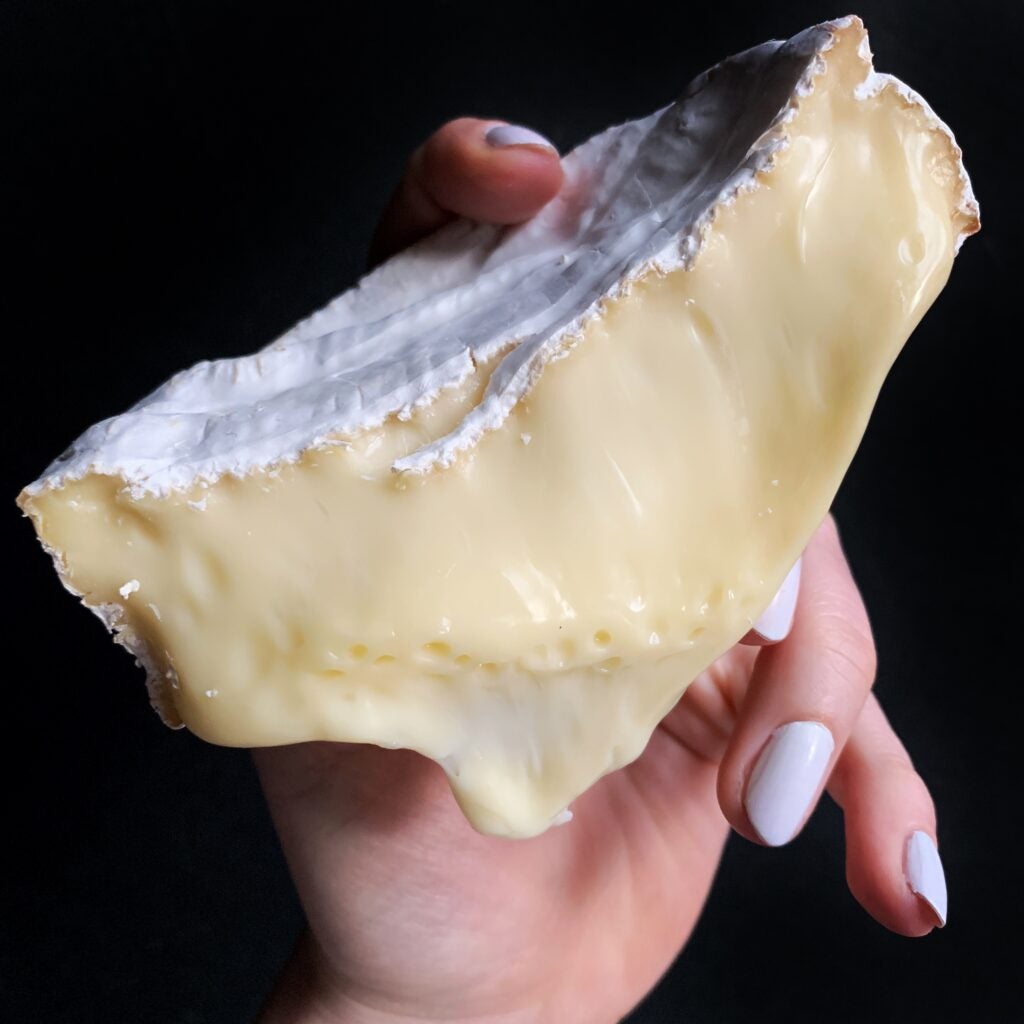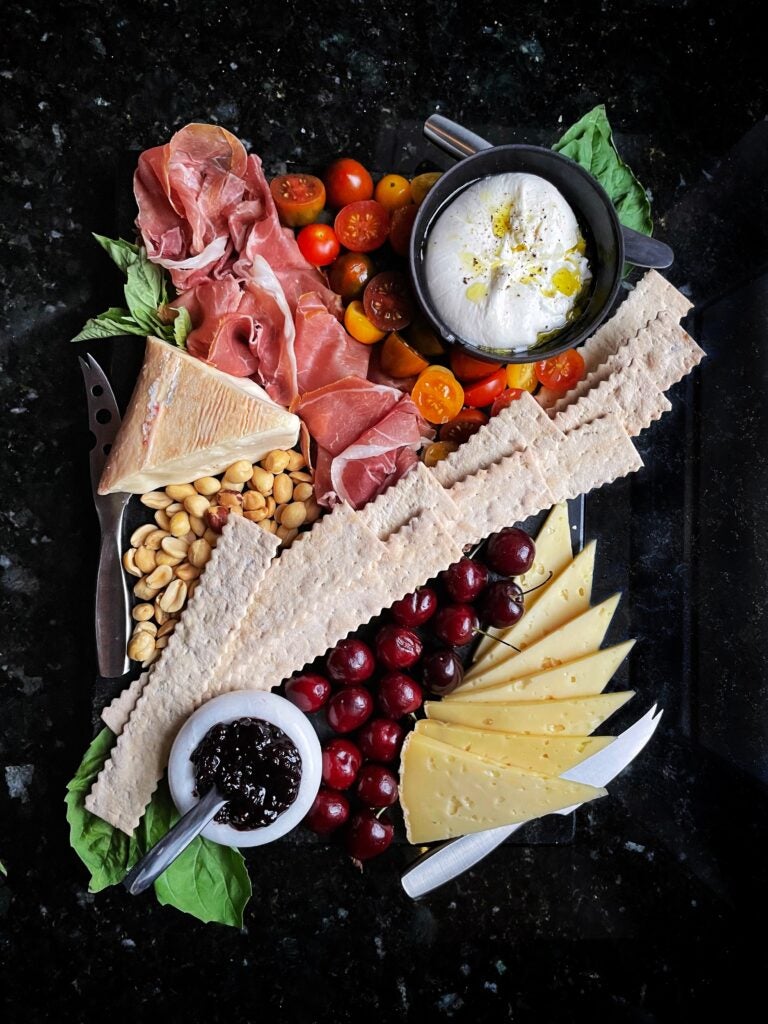
Erika Kubick gives voice to the American cheese revolution.
Suppose it’s Sunday morning, and you’re feeling famished—socially, spiritually, digestively. At the great digital town square, by which I mean, unfortunately, your Instagram or TikTok account, church is open for business, a progressive place of worship where humor and feminism meld with rennet and rind. “Welcome to Cheese Church, where I preach about a cheese and tell you how to pair her. Today we’re worshipping queso fresco…”
This is the work of Cheese Sex Death, the omnichannel media presence of creator Erika Kubick. Kubick is a Chicago-based cheese educator and evangelist in the para-literal sense—her work frequently draws on religious terminology and iconography, from the “Testament of Cheesus” to “Holy Sacraments of Plating,” both chapters in her 2021 Abrams book, subtitled “A Bible for the Cheese Obsessed.” Kubick’s work represents the 21st-century digitization of what writer Anne Saxelby (of blessed memory) called “the American artisan cheese revolution,” a back-to-basics, flavor-focused reinvigoration of the cheese industry that should look familiar to anyone who has followed same-same but different arcs in industries like wine, coffee, and meat.
Cheese’s artisan story has roots in the 1970s American gastronomic movement and was led by cheesemakers like Laura Chenel, Mary Keene (Cypress Grove), Allison Hooper (Vermont Creamery), Laini Fondiller (Lazy Lady Farm), Judy Schad (Capriole Goat Cheese), and many others. These leaders fought in the late 20th century to reclaim cheese from its increasing industrialization; here in the early 21st, Kubick tells the story of these and other great cheesemakers to anyone who will listen, in the grand apostolic tradition, with platforms like TikTok and Instagram as a sort of New Testament.
Sometimes the tone is soft-focused and ethereal (like the Bible), as when profiling Soyoung Scanlan’s outstanding Andante Dairy in Petaluma, California; sometimes the content arrives somewhat more demonic (also like the Bible), as when profiling Red Rock, a cheese by Roelli Cheese Haus of Wisconsin that stitches together cheddar and blue cheese styles, for which Kubick references Frankenstein.

It often feels to me like today’s #food #influencers emerge fully formed, cameras boldly facing their favorite subject matter (themselves); Kubick’s path, by contrast, is more traditional, at least by modern standards. “I started writing blogs in college,” she says (one remembers blogs, yes?), “and they were all terrible.” After finishing school, she balanced an interest in writing alongside work in restaurants, in bars, and at a cheese shop called Pastoral, an influential mini chain in Chicago that has since closed. In 2015 she launched Cheese Sex Death as a good old-fashioned website , balancing regular blogging with a gig in the then still relatively novel social media industry. “I had no idea what I was doing when I got into any of this,” Kubick remembers, “but I got to grow the blog in tandem with a social media career, which was really helpful to me. It’s like I got paid while I learned.”
That social media job, working for a Chicago area restaurant group, frequently put Kubick in contact with the influencer world, an industry that today she feels both a part of and completely apart from. (“I have never felt like I fit in with that crowd.”) Early in the cheese blogging days, she hit on a tone and style that balances a kind of church-gothic aesthetic with an unabashedly feminist take on cheese. “I think it is a very femme product,” she says, laughing about cheese at its most basic. “Like, it comes from a tit, you know? It comes from an animal giving birth and lactating. Historically, cheesemaking was women’s work, and I think that deserves to be honored.” On Kubick’s website and social media accounts, which have, combined, hundreds of thousands of followers, cheese is always a “her,” as in “Roquefort, the queen of cheeses, the mother of all blues.”
This approach to cheese pronouns has not been without controversy, particularly among those for whom rigid gender definitions are an abiding obsession. “Why do you get to dictate who gets to be a woman, and why do you care so much?,” Kubick says. “I use the female pronouns because it’s fun—it’s me having fun with language. But there is such a strong invisible thread to me between cheese and women, and I want to honor that.”
The fusion of cheese education, feminism, and light blasphemy worked, and Kubick’s website enjoyed progressive natural growth and traffic, twinned with an expanding social media presence and in-person events. Today Kubick’s TikTok (260k followers) and Instagram (137k followers) accounts are the main drivers for Cheese Sex Death, with posts that look toward popular culture—particularly television, with which Kubick is obsessed—for recurring cheese pairing ideas, including recent boards dedicated to RuPaul’s Drag Race and the Succession finale. In turn, this growing audience has led to a diversified offering for Cheese Sex Death, the brand, including in-person events and tastings hosted by Kubick and presented with a broad spectrum of collaborators, from indie booksellers to craft cheese shops and artisan creameries to companies like Comté USA and Olympia Provisions.
There is also merch (a “Hail Stilton” beanie and so forth), and Kubick is now 18 months into a promotion cycle for her aforementioned cheese book, including dozens of live events across the country, from Bedford Cheese Shop in New York to Prairie Fruits Farm & Creamery in Illinois to upcoming events in Denver, Seattle, and Portland.

This, to me, feels less like the work of an influencer—although Kubick does (somewhat begrudgingly) embrace the term—and more like the work of someone who took short-form content and blogging as an opportunity and ran with it, finding an area of the food world that could use a shot in the arm. “If being an influencer means I get to call out great cheeses and how to pair them, I am grateful for it,” she says, “but my top goal is to be an educator. My goal is not to grow a following. . . . My goal is to help people and help the cheese industry.”
You will find no basic grocery-store brie on Kubick’s grid. Instead, her focus is doggedly singing the praises of small craft creameries, artisan cheesemakers, and the occasional quality-minded cheese cooperative alongside the mongers, distributors, and fellow online cheese educators who really, truly care about this stuff. Kubick’s work functions, in this way, as a layer of curation: She resolutely only cares about the good shit, and that’s all her account talks about, which is no easy feat to pull off.
This is a major differentiator between Kubick’s work and, say, the billionth top-down cheese board tableau you saw in 2018, where the actual cheese being served was often an afterthought. By building her brand around a signature voice and highlighting interesting cheese stories, Kubick has arrived at a mode of content that feels more like genuine advocacy—worship, even.
I’m one of those followers, attending digital cheese church on Sundays and referencing her book for pairing suggestions. On a recent Friday night—the holy evening in my household—I found myself, as I often do, in the mood for some good cheese. I was in the somewhat enviable position of possessing a very good block of gouda, which, truth be told (please do not report me), I’d recently smuggled home in my luggage from one of those beautiful little weekend markets in Amsterdam. This wasn’t just aged gouda, it was old gouda—five years, bro—burnt orange in hue with gnarled flavors of butterscotch and a salty crystalline crunch (the good shit).
Kubick’s book has the most perfect, off-the-wall, gonzo, Luke 17:24 lightning bolt of a pairing for this sort of cheese: dark chocolate cookies. “Chip crumbles off the Gouda,” she writes, “and gently push into the center of the cookie.” I would never in a million years have thought to do this, but holy wow—nu breekt mijn klomp, as they say in Holland—the chocolate wraps itself around the gouda like caramel, and those aged cheese crystals function as a sort of super salt for the cookie top. The end result is something rhapsodic, a note from the angels.
No sin could sully a mortal’s soul ‘twixt earthly flavors like these, for it is the very taste of heaven.
Rabbit Hole is a column that digs deep into nodes of culinary inquiry, from the recipes and products that expand our home routines to the food culturalists and content creators that make us hungry and curious. Along the way, we’re exploring the ever golden gastronomic moment in the 21st century: never boring, always peckish.